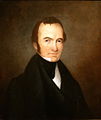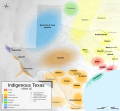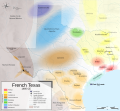The Texas Portal
Texas (/ˈtɛksəs/ TEK-səss, locally also /ˈtɛksɪz/ TEK-siz; Spanish: Texas or Tejas, pronounced [ˈtexas]) is the most populous state in the South Central region of the United States. It borders Louisiana to the east, Arkansas to the northeast, Oklahoma to the north, New Mexico to the west, and an international border with the Mexican states of Chihuahua, Coahuila, Nuevo León, and Tamaulipas to the south and southwest. Texas has a coastline on the Gulf of Mexico to the southeast. Covering 268,596 square miles (695,660 km2), and with over 30 million residents as of 2023, it is the second-largest state by both area and population. Texas is nicknamed the Lone Star State for its former status as an independent republic. Spain was the first European country to claim and control the area of Texas. Following a short-lived colony controlled by France, Mexico controlled the territory until 1836 when Texas won its independence, becoming the Republic of Texas. In 1845, Texas joined the United States as the 28th state. The state's annexation set off a chain of events that led to the Mexican–American War in 1846. Following victory by the United States, Texas remained a slave state until the American Civil War, when it declared its secession from the Union in early 1861 before officially joining the Confederate States of America on March 2. After the Civil War and the restoration of its representation in the federal government, Texas entered a long period of economic stagnation. Historically, five major industries shaped the Texas economy prior to World War II: cattle, bison, cotton, timber, and oil. Before and after the Civil War, the cattle industry—which Texas came to dominate—was a major economic driver and created the traditional image of the Texas cowboy. In the later 19th century, cotton and lumber grew to be major industries as the cattle industry became less lucrative. Ultimately, the discovery of major petroleum deposits (Spindletop in particular) initiated an economic boom that became the driving force behind the economy for much of the 20th century. Texas developed a diversified economy and high tech industry during the mid-20th century. As of 2022[update], it has the most Fortune 500 company headquarters (53) in the United States. With a growing base of industry, the state leads in many industries, including tourism, agriculture, petrochemicals, energy, computers and electronics, aerospace, and biomedical sciences. Texas has led the U.S. in state export revenue since 2002 and has the second-highest gross state product. (Full article...) Selected article -Plano Senior High School (commonly Plano, Plano Senior High, or PSHS) is a public secondary school in Plano, Texas, serving students in grades 11–12. The school is part of the Plano Independent School District, with admission based primarily on the locations of students' homes. Plano is a two-time Blue Ribbon School and a Texas Exemplary School. Students at Plano Senior typically attended one of two feeder high schools: Clark or Vines. Founded in 1891 as Plano Public School, serving both primary and secondary students, the school was, by the mid-1910s, sending a majority of its graduating students on to college. Plano High School, created in 1952 by separating the primary students into Mendenhall Elementary School, was immediately accredited by the Southern Association of Colleges and Schools, allowing its graduates to enter college without taking an entrance exam. In 1964, Plano High School integrated with the Frederick Douglass School (formerly Plano Colored School), and the integrated football team won the first of the school's seven state championships in 1965. In 1975, the school moved to a new 96-acre (39 ha) campus with five buildings, very similar to the layout of a junior college, where it has remained since. The old building is now the T. H. Williams High School, serving 9th and 10th grade. During the first year only at the new campus, PSHS served 10th – 12th grade, making the Class of 1978 the only class to attend school at this campus for three years. (Full article...) Selected biography -William Roger Clemens (born August 4, 1962), nicknamed "Rocket", is an American former professional baseball pitcher who played 24 seasons in Major League Baseball (MLB), most notably with the Boston Red Sox, Toronto Blue Jays, and New York Yankees. He was one of the most dominant pitchers in major league history, tallying 354 wins, a 3.12 earned run average (ERA), and 4,672 strikeouts, the third-most all time. An 11-time MLB All-Star and two-time World Series champion, Clemens won seven Cy Young Awards, more than any other pitcher in history. Clemens was known for his fierce competitive nature and hard-throwing pitching style, which he used to intimidate batters. Clemens debuted in the MLB in 1984 with the Red Sox, whose pitching staff he anchored for 12 years. In 1986, he won the American League (AL) Cy Young Award, the AL Most Valuable Player (MVP) Award, and the All-Star Game MVP Award, and he struck out an MLB-record 20 batters in a single game. After the 1996 season, in which he achieved his second 20-strikeout performance, Clemens left Boston via free agency and joined the Toronto Blue Jays. In each of his two seasons with Toronto, Clemens won a Cy Young Award, as well as the pitching triple crown by leading the league in wins, ERA, and strikeouts. Before the 1999 season, Clemens was traded to the Yankees where he won his two World Series titles. In 2001, Clemens became the first pitcher in major league history to start a season with a win–loss record of 20–1. In 2003, he reached his 300th win and 4,000th strikeout in the same game. Clemens left for the Houston Astros in 2004, where he spent three seasons and won his seventh Cy Young Award. He rejoined the Yankees in 2007 for one last season before retiring. He is the only pitcher in Major League history to record more than 350 wins and strike out more than 4,500 batters. (Full article...) Texas news
Wikinews Texas portal
ListsState symbols
Texas topicsSelected imageCities -Brownsville (/ˈbraʊnzˌvɪl/) is a city in the U.S. state of Texas and the seat of Cameron County, located on the western Gulf Coast in South Texas, adjacent to the border with Matamoros, Tamaulipas, Mexico. The city covers 145.2 sq mi (376.066 km2), and had a population of 186,738 at the 2020 census. As of the 2020 U.S. Census, it is the 135th-largest city in the United States and 18th-largest in Texas. It is part of the Matamoros–Brownsville metropolitan area. The city is known for its year-round subtropical climate, deep-water seaport, and Hispanic culture. The city was founded in 1848 by American entrepreneur Charles Stillman after he developed a successful river-boat company nearby. It was named for Fort Brown, itself named after Major Jacob Brown, who fought and died while serving as a U.S. Army soldier during the Mexican–American War (1846–1848). As a county seat, the city and county governments are major employers. Other primary employers fall within the service, trade, and manufacturing industries, including a growing aerospace and space transportation sector. It operates international trading through the Port of Brownsville. The city experienced a population increase in the early 1900s, when steel production flourished. (Full article...) General imagesThe following are images from various Texas-related articles on Wikipedia.
CategoriesSelect [►] to view subcategories
Related pages
Attractions
 Things you can doAssociated WikimediaThe following Wikimedia Foundation sister projects provide more on this subject:
SourcesMore portals | ||||||||||||||||||||||||||||||||||||||||

































































